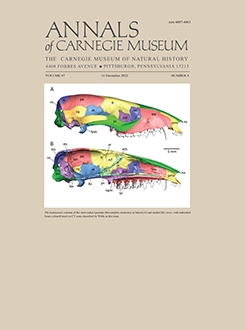William W. Korth
Annals of Carnegie Museum 87 (4), 309-326, (31 December 2022) https://doi.org/10.2992/007.087.0403
KEYWORDS: cranial and dental morphology, Leptictida, North American Land Mammal Ages, Renova Formation
Previously unreported material of leptictids (Mammalia: Leptictida) is described from three latest Eocene localities in Montana: Pipestone Springs (Ch3), McCarty's Mountain (Ch2), and Diamond O Ranch (Du–Ch1). Additional and more complete specimens of Leptictis acutidens (Douglass, 1901) from its type locality are also described. The first specimens of Leptictis intermedius (Douglass, 1905) outside of the type locality of McCarty's Mountain are described from the Diamond O Ranch fauna. Although previously suggested as a synonym of Leptictis montanus (Douglas, 1905), L. intermedius is recognized as a distinct species based on its smaller size, cranial features (narrower zygomatic arch, single squamosal sinus canal, large suprameatal foramen), and dental features (paraconule transversely elongated and more lingual than metaconule on P5–M3; and metacone moderately to well developed on M3).
Leptictis thomsoni (Matthew, 1903) is referred to a new genus, Stenoleptictis based on previously undescribed lower dentitions and crania from both Pipestone Springs (type locality) and McCarty's Mountain. The most diagnostic characters of Stenolepticis thomsoni (Matthew, 1903), new combination, are the lingually narrower upper cheek teeth with reduced anterior cingula and the presence of more lateral, lyrate parasagittal crests on the cranium, features unreported in any other leptictids.

